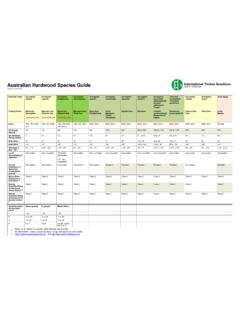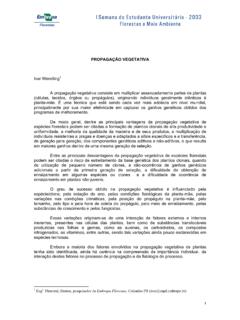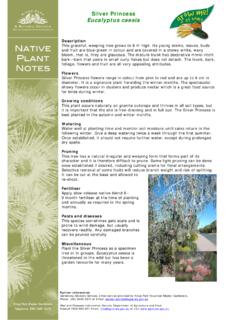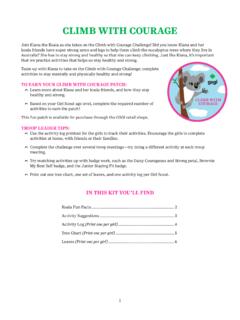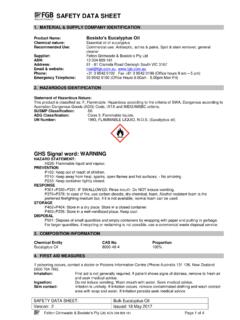Transcription of SAFETY DATA SHEET - MSDS
1 Pine O Cleen Disinfectant Liquid ( eucalyptus )1. Identification of the material and supplierSAFETY DATA SHEETP roduct name:SDS #:Material usesSurface Care:D8366723 - 13 11 26 New Zealand - 0800 764 766 or 0800 POISON Poison Information contact::Formulation #: 3095422 Supplier:AUSTRALIARB (Hygiene Home) Australia Pty LtdABN: 58 629 549 506 680 George St , Sydney, NSW 2000 Tel: +61 (0)2 9857 2000 NEW ZEALANDRB (Hygiene Home) New Zealand LimitedCompany number: 70977532 Fred Thomas Drive, TakapunaAuckland , New Zealand 0622 Tel: +64 9 484 1400 Consumer:Product useThis SDS is prepared in accord with the SWA document Preparation of SAFETY Data Sheets for Hazardous Chemicals - Code of Practice (Feb 2016).Section 2. Hazard(s) identificationSKIN CORROSION/IRRITATION - Category 2 SERIOUS EYE DAMAGE/ EYE IRRITATION - Category 2 AClassification of the substance or mixture:Signal word:WARNINGH azard statements:Causes serious eye skin pictograms:Precautionary statementsPrevention:Wash hands thoroughly after protective gloves and eye :IF ON SKIN: wash with plenty of soap and SKIN irritation occurs: Get medical off contaminated clothing and wash it before IN EYES: Rinse cautiously with water for several minutes.
2 Remove contact lenses, if present and easy to do. Continue eye irritation persists: Get medical :Not :Dispose of contents and container in accordance with all local label elementsGeneral:Keep out of reach of children. If medical advice is needed, have product container or label at label elements:Not , , of issuePage: 1/1022/10/2019:D8366723 2. Hazard(s) identificationOther hazards which do not result in classification:None 3. Composition and ingredient informationquaternary ammonium compounds, benzyl-C8-18-alkyldimethyl, chlorides nameCAS number Other Non-hazardous ingredients to 100%Substance/mixture:Occupational exposure limits, if available, are listed in Section (w/w)Wash out mouth with water. Remove dentures if any. Remove victim to fresh air and keep at rest in a position comfortable for breathing. If material has been swallowed and the exposed person is conscious, give small quantities of water to drink.
3 Stop if the exposed person feels sick as vomiting may be dangerous. Do not induce vomiting unless directed to do so by medical personnel. If vomiting occurs,the head should be kept low so that vomit does not enter the lungs. Get medical attention if adverse health effects persist or are severe. Never give anything by mouth to an unconscious person. If unconscious, place in recovery position and get medical attention immediately. Maintain an open airway. Loosen tight clothing such as a collar, tie, belt or flush eyes with plenty of water, occasionally lifting the upper and lower eyelids. Check for and remove any contact lenses. Continue to rinse for at least 10 minutes. Get medical contaminated skin with plenty of water. Remove contaminated clothing and shoes. Continue to rinse for at least 10 minutes. Get medical attention. Wash clothing before reuse. Clean shoes thoroughly before victim to fresh air and keep at rest in a position comfortable for not breathing, if breathing is irregular or if respiratory arrest occurs, provide artificial respiration or oxygen by trained personnel.
4 It may be dangerous to the person providing aid to give mouth-to-mouth resuscitation. Get medical attention if adverse health effects persist or are severe. If unconscious, place in recovery position and get medical attention immediately. Maintain an open airway. Loosen tight clothing such as a collar, tie, belt or 4. First aid measuresEye contactSkin contactInhalationIngestion::::Descriptio n of necessary first aid measuresMost important symptoms/effects, acute and delayedInhalation:No known significant effects or critical known significant effects or critical hazards.:IngestionSkin contact:Causes skin serious eye irritation.:Eye contactOver-exposure signs/symptomsSkin contactIngestionInhalationNo specific specific symptoms may include the following:irritationredness:::Eye contact:Adverse symptoms may include the following:pain or irritationwateringrednessPotential acute health effectsDate of issuePage: 2/1022/10/2019:D8366723 4.
5 First aid measuresProtection of first-aiders:No action shall be taken involving any personal risk or without suitable training. It may be dangerous to the person providing aid to give mouth-to-mouth to physician:Treat symptomatically. Contact poison treatment specialist immediately if large quantities have been ingested or treatments:No specific toxicological information (Section 11)Indication of immediate medical attention and special treatment needed, if necessarySection 5. Fire-fighting measuresPromptly isolate the scene by removing all persons from the vicinity of the incident if there is a fire. No action shall be taken involving any personal risk or without suitable thermal decomposition productsSpecific hazards arising from the chemicalNo specific a fire, hazardous decomposition products may be should wear appropriate protective equipment and self-contained breathing apparatus (SCBA) with a full face-piece operated in positive pressure protective actions for fire-fightersUse an extinguishing agent suitable for the surrounding media:::None extinguishing media:Unsuitable extinguishing media:Special protective actions for fire-fighters:Section 6.
6 Accidental release measuresEnvironmental precautionsPersonal precautions, protective equipment and emergency procedures::No action shall be taken involving any personal risk or without suitable surrounding areas. Keep unnecessary and unprotected personnel from entering. Do not touch or walk through spilled material. Avoid breathing vapor or mist. Provide adequate ventilation. Wear appropriate respirator when ventilation is inadequate. Put on appropriate personal protective dispersal of spilled material and runoff and contact with soil, waterways,drains and sewers. Inform the relevant authorities if the product has caused environmental pollution (sewers, waterways, soil or air).Stop leak if without risk. Move containers from spill area. Dilute with water and mop up if water-soluble. Alternatively, or if water-insoluble, absorb with an inert dry material and place in an appropriate waste disposal container.
7 Dispose of via a licensed waste disposal spill:Methods and materials for containment and cleaning upFor non-emergency personnelFor emergency responders:If specialized clothing is required to deal with the spillage, take note of any information in Section 8 on suitable and unsuitable materials. See also the information in "For non-emergency personnel".Date of issuePage: 3/1022/10/2019:D8366723 6. Accidental release measuresStop leak if without risk. Move containers from spill area. Approach release from upwind. Prevent entry into sewers, water courses, basements or confined spillages into an effluent treatment plant or proceed as follows. Contain and collect spillage with non-combustible, absorbent material sand, earth,vermiculite or diatomaceous earth and place in container for disposal according to local regulations (see Section 13). Dispose of via a licensed waste disposal contractor. Contaminated absorbent material may pose the same hazard as the spilled product.
8 Note: see Section 1 for emergency contact information and Section 13 for waste spill:See Section 1 for emergency contact Section 8 for information on appropriate personal protective Section 13 for additional waste treatment 7. Handling and storageAdvice on general occupational hygieneConditions for safe storage,including any incompatibilitiesEating, drinking and smoking should be prohibited in areas where this material is handled, stored and processed. Workers should wash hands and face before eating, drinking and smoking. Remove contaminated clothing and protective equipment before entering eating areas. See also Section 8 for additional information on hygiene in accordance with local regulations. Store in original container protected from direct sunlight in a dry, cool and well-ventilated area, away from incompatible materials (see Section 10) and food and drink. Keep container tightly closed and sealed until ready for use.
9 Containers that have been opened must be carefully resealed and kept upright to prevent leakage. Do not store in unlabeled appropriate containment to avoid environmental contamination.::Protective measuresPut on appropriate personal protective equipment (see Section 8). Do not contact with eyes, skin and clothing. Avoid breathing vapor or mist. Keep in the original container or an approved alternative made from a compatible material,kept tightly closed when not in use. Empty containers retain product residue and can be hazardous. Do not reuse container.:Precautions for safe 8. Exposure controls and personal protectionEnvironmental exposure controls:Emissions from ventilation or work process equipment should be checked to ensure they comply with the requirements of environmental protection legislation. In some cases, fume scrubbers, filters or engineering modifications to the process equipment will be necessary to reduce emissions to acceptable engineering controls:Good general ventilation should be sufficient to control worker exposure to airborne hands, forearms and face thoroughly after handling chemical products, before eating, smoking and using the lavatory and at the end of the working techniques should be used to remove potentially contaminated contaminated clothing before reusing.
10 Ensure that eyewash stations and SAFETY showers are close to the workstation measures:Control parametersIndividual protection measuresOccupational exposure limitsAustraliaNew ZealandOccupational exposure limits:No exposure standard of issuePage: 4/1022/10/2019:D8366723 8. Exposure controls and personal protectionHand protectionBased on the hazard and potential for exposure, select a respirator that meets the appropriate standard or certification. Respirators must be used according to a respiratory protection program to ensure proper fitting, training, and other important aspects of the parameters specified by the glove manufacturer, check during use that the gloves are still retaining their protective properties. It should be noted that the time to breakthrough for any glove material may be different for different glove manufacturers. In the case of mixtures, consisting of several substances, the protection time of the gloves cannot be accurately eyewear complying with an approved standard should be used when a risk assessment indicates this is necessary to avoid exposure to liquid splashes, mists,gases or dusts.





